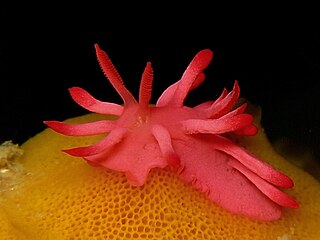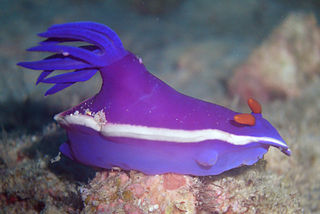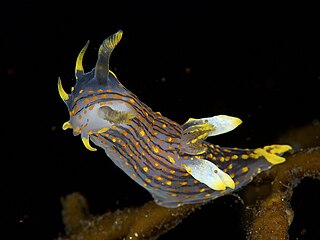
Armina is a genus of sea slugs, specifically nudibranchs, marine gastropod mollusks in the family Arminidae.

Nembrotha is a genus of sea slugs, nudibranchs, marine gastropod molluscs in the family Polyceridae.

Okenia is a genus of colorful sea slugs, specifically of dorid nudibranchs, marine gastropod mollusks in the family Goniodorididae.

Tritonia is a genus of sea slugs, nudibranchs, shell-less marine gastropod molluscs in the family Tritoniidae.

Hypselodoris is a genus of colourful sea slugs or dorid nudibranchs, marine gastropod mollusks in the family Chromodorididae. Modern usage follows a more restricted view of which species belong in this genus so there are numerous genus transfers.

Acanthodoris is a genus of sea slugs, dorid nudibranchs, shell-less marine gastropod mollusks in the family Onchidorididae. The genus is believed to have originated in the Atlantic Ocean in the Cretaceous period and spread to the Pacific Ocean. The relationships of Acanthodoris to the other genera in the family Onchidorididae were evaluated by molecular phylogeny in 2015.
Cuthona is a genus of nudibranch in the family Cuthonidae.

Polycera is a genus of sea slugs, specifically nudibranchs, shell-less marine gastropod molluscs in the family Polyceridae.

Flabellina is a genus of sea slugs, specifically aeolid nudibranchs. These animals are marine gastropod molluscs in the family Flabellinidae.

The Facelinidae are a taxonomic family of colorful sea slugs. These are specifically aeolid nudibranchs. They are marine gastropod molluscs.

Doriopsilla is a genus of sea slugs, dorid nudibranchs, shell-less marine gastropod molluscs in the family Dendrodorididae.

Eubranchus is a genus of aeolid nudibranch in the family Eubranchidae.

Cratena is a genus of sea slugs, aeolid nudibranchs, marine gastropod molluscs in the family Facelinidae.

Tambja is a genus of colorful sea slugs, dorid nudibranchs, shell-less marine gastropod mollusks in the family Polyceridae.

Geitodoris is a genus of sea slugs, dorid nudibranchs, shell-less marine gastropod mollusks in the family Discodorididae.

Thordisa is a genus of sea slugs, dorid nudibranchs, shell-less marine gastropod mollusks in the family Discodorididae.

Marionia is a genus of sea slugs, specifically dendronotid nudibranchs, marine gastropod molluscs in the family Tritoniidae.

Antiopella is a genus of small to large sea slugs, or more accurately nudibranchs, marine gastropod mollusks, in the family Janolidae.
Janolus flavoanulatus is a sea slug species. The specific name is derived from Latin words flavus (“yellow”) and anulatus (“ringed”). These soft-bodied mollusks are known for their extraordinary colors and prominent forms. The first description of this species was reported by researcher Terry Gosliner, a leading researcher in the evolutionary history of nudibranchs. Upon his conducted research in the Philippines, Gosliner named Janolus flavoanulatus for its yellow ring around its cerata.

















